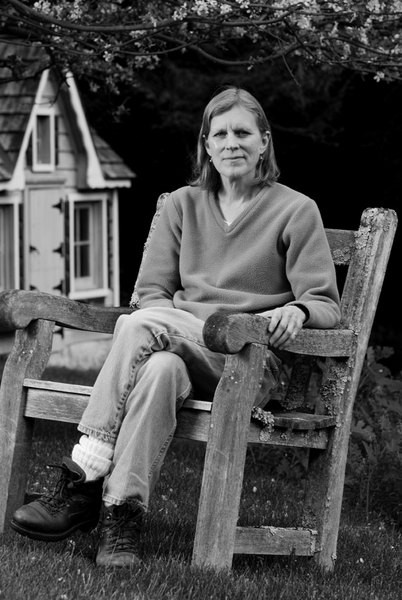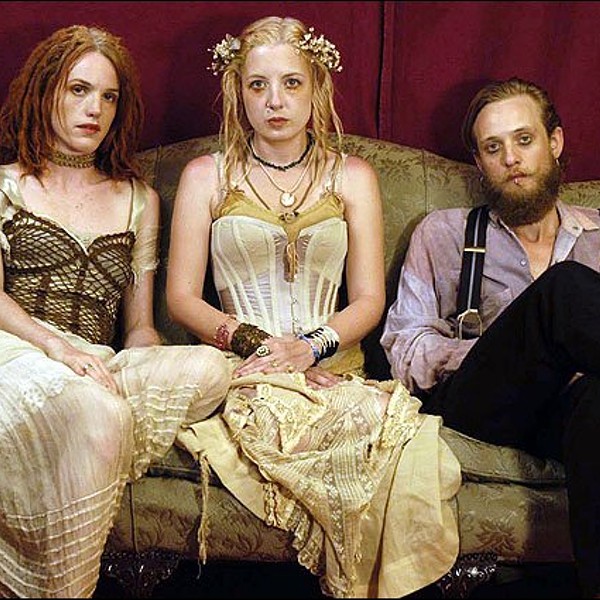
Name a small town with the following Christmas Eve tradition:
“After the parade, Santa Claus arrived in town and not just waving from the last float. No, the method of his arrival was magical and unexpected and different every year. No one (except the mayor) knew who played Santa; it was a big [town] secret. And no one knew how he would appear. Min said that once Santa had sprung out of a giant jack-in-the-box in the town square, and once he had been flown in on a helicopter, and once he had even ridden down Main Street on an elephant.”
If you answered “Woodstock,” you’re not far off. The small town with the mysteriously athletic Santa is Camden Falls, Massachusetts, created by bestselling young adult author Ann M. Martin for her latest series. “Woodstock was definitely my inspiration for Main Street,” Martin affirms between bites of a grilled veggie sandwich from Bread Alone. Soft-spoken, petite, and simply dressed in a pink fleece sweatshirt and jeans, she’s extraordinary self-effacing for a publishing phenomenon.
Martin’s long-running series The Baby-Sitters Club has sold more than 176 million copies, prompting Publishers Weekly to declare, “Ann M. Martin rules the paperback roost.” Her other books include the award-winning A Corner of the Universe, Belle Teal, and A Dog’s Life: The Autobiography of a Stray, plus two more series coauthored with Laura Godwin (Doll People) and the late Paula Danziger (P.S. Longer Letter Later and Snail Mail, No More)—in all, over 200 titles.
Martin never imagined such a prodigious output when she published her first book, Bummer Summer, in 1983. A recent Smith College graduate, she worked as an editor at Scholastic and Bantam Books. The Baby-Sitters Club was originally sold as a series of four, and Martin remembers her editor talking about how to construct a story arc that spanned several books. “I’d never heard the term ‘story arc.’ I didn’t know what I was doing—I was just thinking of each book and how to tell that story best.”
Clearly her instincts were golden. Scholastic commissioned more BSC books right away, planning to release four per year. “I was surprised and very grateful,” Martin says. By book number six, “they realized it was taking off, and the schedule jumped up to one a month.” Scholastic also launched the Little Sister spinoff series, hiring a small staff of regular writers to work from Martin’s detailed outlines, like a TV staff working with a head writer who plots, supervises, and does final line-editing to maintain a consistent voice. By the time the Baby-Sitters Club’s perennial eighth-graders booked their last client in 2000, Martin had been on the production treadmill for 14 years. “I thought I would never write a series again,” she asserts.
But one of her BSC editors, David Levithan, wooed her back via her love of sewing. “Maybe he left me alone for four years,” she grins, clearly fond of the man who cajoled her into creating Main Street, which debuted in May 2007.
Camden Falls’ Main Street features less tie-dyed versions of such Tinker Street mainstays as the Golden Notebook, Clouds, and the Woodstock Wool Company, locus in quo for Martin’s sewing store and community hub, Needle & Thread. The hardware store with knotholes in the floor was actually in Princeton, NJ, where Martin grew up. “We used to lie on our stomachs on the floor trying to peer through those knotholes and see what was below,” she recalls.
Seeing what’s below is one of the author’s recurring themes. Though the New England facades of Camden Falls’ shops and row houses seem Norman Rockwell timeless, Martin is careful to fill their interiors with lives that are not picture-perfect. Her two leading characters, sisters Flora and Ruby, lose both parents in a car accident and come to live with their practical grandmother, Min, co-owner of Needle & Thread. Min’s neighbors include two Chinese artists, an African-American widower struggling to remain independent, and families coping with a mentally handicapped teenager, Alzheimer’s disease, and the shame of poverty.
These edgy topics unfold in a reassuringly old-fashioned context, penned by a writer who actually says things like “Gosh!” At a time when most fiction aimed at tween girls reads like chick lit in a training bra, it’s refreshing to see middle-school characters act their own age.
“I always wanted to write children’s books because they were so important to me growing up,” Martin says. She was raised in a household in which reading aloud and library visits were family activities. Her mother taught preschool, and her father was a New Yorker cartoonist; young Ann met his colleagues George Booth and Charles Addams. Though Henry Martin kept a studio downtown, he often worked at home in the evenings. His daughter remembers standing behind his chair, watching him draw.
Martin describes her child self as “much more like Flora than Ruby,” an introspective, studious girl who loved sewing and crafts, and was scared to try sleepaway camp. Her vivid imagination concocted a family of foxes under her bed. “When I got out of bed, I would leap three or four feet away so Mr. and Mrs. Fox couldn’t get me. I sort of knew they weren’t really there, but I still had to leap,” she says, adding that she always slept with the light on. Though her younger sister Jane acted in community theatrical productions, Ruby’s “singing, dancing, ta-da! personality” also borrows from Doll People coauthor Laura Godwin’s younger niece.
The collaboration with Godwin opened new doors for both writers. Godwin’s previous works were picture books, and Martin had not written fantasy, which she insists she “would never have tried without Laura.” When working with free-spirited Paula Danziger, Martin, a self-described “compulsive outliner,” learned to be more spontaneous. She now writes “anywhere,” toting her laptop onto the porch in good weather, or using the dining room table to spread out her copious notes.
Martin bought her house outside Woodstock in 1990—the same year she launched two charitable foundations with her BSC earnings. A well-hidden, lushly gardened Victorian fantasy erected in 1907, the house features an imposing four-story tower built five years later. Martin’s filled it with lovely antiques—a grandfather clock, a Victrola, a Rosebud-like sled, a glass-front cabinet packed with Limoges china boxes—which add to its pervasive aura of vintage magic: one would not be surprised to find Narnian fauns in its wardrobes, or keyholes leading to secret gardens.
The interior features two back-to-back stairwells that somehow suggest the inside of a lighthouse, possibly one drawn by Edward Gorey. One leads to the light-filled sewing room in which Martin relaxes with pleating machines and embroidery hoops, making intricate smocked dresses for her friends’ daughters. The second leads up to her writing office, the only room in the house that isn’t impeccably neat, thanks to a mischievous foster kitten named Pippin.
Martin is an animal lover whose household often includes foster pets. A lifelong cat person, she took in her first dog 10 years ago. A silky blond golden retriever/beagle mix with a BSC zipper pull on her collar, Sadie was born to a stray taken in by a volunteer just before giving birth; Martin and others adopted the puppies. “Sadie’s so shy—I often wonder what would have happened if nobody rescued her mother,” Martin says with a shudder. This line of inquiry inspired her award-winning novel A Dog’s Life, which follows the sometimes heartrending fate of two stray puppies born in a summer house toolshed; she’s currently planning a sequel.
For someone who writes so much about the complex emotional lives of children and animals, Martin is strikingly reticent about her own. This may be temperamental—she refers several times to her shyness, a problem she overcomes on book tours by using PowerPoint presentations—or a buttoned-down remnant of the WASP heritage she can trace back to the Mayflower.
It’s telling that even what Martin calls her most personal book, Newbery Honor winner A Corner of the Universe, is based on tales of her mother’s mentally ill younger brother, who died before Martin was born. But her 12-year-old narrator channels a pitch-perfect first-person voice. Hattie is a shy nonconformist in a town where the biggest divide is between Presbyterians and Episcopalians. Into this straitlaced community comes Uncle Adam, a schizophrenic savant just discharged from the residential school where his tight-lipped parents have tucked him away. Inappropriately dressed for every occasion and constitutionally incapable of hiding emotions that swing from childlike glee to frightening volatility, Adam is like nobody Hattie has ever met. Her reflections at the book’s end could serve as a credo for Ann M. Martin’s fiction:
“I thank Adam, as I have thanked him almost every night since August, for showing me that it’s possible to lift the corners of our universe. Adam told me about lifting the corners the second time I met him, but I had no idea what he meant. Now I think I do. It’s about changing what’s handed to you, about poking around a little, lifting the corners, seeing what’s underneath, poking that. Sometimes things work out, sometimes they don’t, but at least you’re exploring. And life is always more interesting that way.”
















